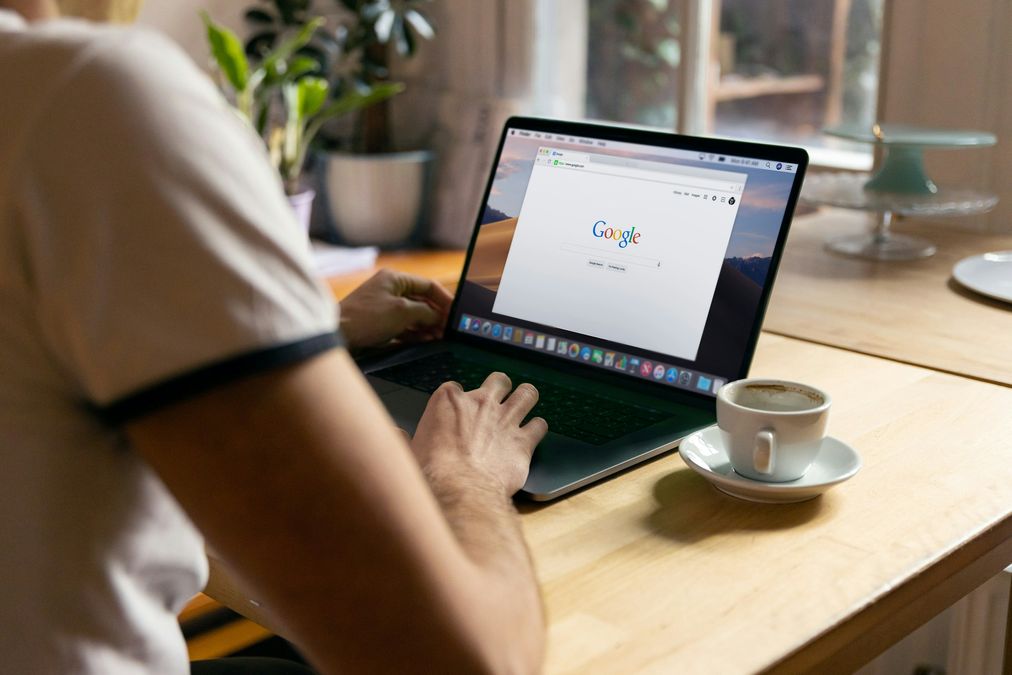Blog|Marketing
Hoger in Google met goede SEO content
Zet met onze tips de eerste stap naar een beter leesbare website, voor Google én je bezoeker!

Wat is SEO?
SEO staat voor Search Engine Optimalisation. Zoekmachines zoals Google gebruiken verschillende indicatoren om te kijken hoe relevant jouw website is voor een zoekopdracht van een potentiële bezoeker. Zaken als naamsbekendheid, reviews en locatie zijn voorbeelden van de vele variabelen die Google hiervoor gebruikt.
Maar Google kijkt ook naar de opmaak en inhoud van jouw website of blog. Content is daarom een ontzettend belangrijk onderdeel van SEO. Door jouw content af te stemmen op zoekopdrachten en veelgestelde vragen ben jij een relevanter resultaat voor Google en dus sneller te vinden door een potentiële klant.
In dit artikel geven we je een aantal tips voor het schrijven van goede SEO-content, maar we helpen je uiteraard ook graag persoonlijk verder.
SEO voor beginners
Stel jij verkoopt wasmachines. Dan is je eerste insteek waarschijnlijk om een pagina te schrijven met in de tekst lekker vaak de zoekterm ”wasmachine kopen”. Je bent echter niet de enige met dit briljante idee, en je concurrenten hebben gegarandeerd vergelijkbare SEO pagina’s geschreven om deze klanten op te vangen.
Zonde, want nu forceer je Google om terug te vallen op andere variabelen zoals grote van de webwinkel of reviews, waar je concurrenten misschien beter naar voren komen. Daarnaast kan Google bepalen of de tekst op een pagina “natuurlijk” te lezen is, of dat er bewust veel keywords in de tekst zijn opgenomen (ook wel stuffing genoemd). Het is dus interessanter en effectiever om je content te onderscheiden van je concurrent, zonder daarbij in te leveren aan relevantie.
Want waarom zoekt de klant eigenlijk op wasmachine kopen? Is het misschien een student die voor het eerst uit huis gaat? Dan ging de zoekopdracht ”waar moet ik op letten bij mijn eerste wasmachine” hier waarschijnlijk aan vooraf.
Of misschien is de wasmachine stuk en heeft de klant eerst gezocht of er een simpele oplossing was voor het probleem. Als jij die zoekopdracht opvangt met een blog of productpagina met het antwoord op die vragen en vervolgens ook de mogelijkheid biedt om bij jou meteen een nieuwe wasmachine te kopen, dan haal jij de klant al een stap vóór de aankoopintentie binnen.

Welke zoekwoorden kan je het best gebruiken?
Uiteraard is het niet mogelijk om elke potentiële vraag van de klant op te vangen, maar bovenstaand voorbeeld laat wel goed zien hoe je creatief kan zijn met zowel content als zoekwoorden. Zoekwoorden moeten een goede match zijn voor de verschillende soorten zoekintenties waar jouw content op gericht is. Voorbeelden van een zoekintentie van een bezoeker kunnen zijn: oriëntatie en behoefte aan algemene informatie, op zoek naar een product of dienst, behoefte aan contact of een aankoop willen doen.
Het is belangrijk om de zoekintentie van de bezoeker te gebruiken bij de opzet van je pagina, wil je hier converteren of informeren? Heb je bijvoorbeeld een webwinkel en blog over smartwatches? Bewaar dan de zoekwoorden die passen bij een koopintentie, zoals ‘’smartwatch kopen’’ voor je productpagina’s en focus bij je blog juist op de zoekwoorden die passen bij een verzoek aan informatie, zoals ‘’functies van een smartwatch’’.
Omdat goed gekozen zoekwoorden de basis vormen voor goede SEO-content is het belangrijk om hier vanaf het begin over na te denken. Vervolgens schrijf je de tekst om deze zoekwoorden heen, zonder de intentie van de pagina uit het oog te verliezen. Voor het beste resultaat maak je gebruik van zoekwoorden met een hoog zoekvolume, maar niet te veel concurrentie.
Een fout die hierbij nog veel gemaakt wordt is het gebruik van vakjargon of zoektermen die oriënterende klanten (nog) niet kennen of logischerwijs gebruiken. Het is cruciaal om je te verplaatsen in de bezoeker die nog niet eerder kennis heeft gemaakt met jouw bedrijf, product of expertise.
Wil je hulp met het vinden van de juiste zoekwoorden voor jouw website of artikel?
Opmaak is belangrijk voor SEO
Zoekmachines worden steeds beter in het detecteren van goede content. Een lange lap tekst zonder opmaak bevat dan misschien wel alle relevante informatie en zoekwoorden, een onleesbaar en rommelig artikel jaagt je lezer weg. Grote kans dat jij bij het lezen van dit artikel ook gebruik hebt gemaakt van de kopjes om snel onderdelen die je aanspreken te scannen. Titels en koppen zijn altijd belangrijk voor content, maar al helemaal als het gaat om SEO. Zoekwoorden in kopjes worden hoger gewaardeerd omdat zoekmachines er vanuit gaan dat dit je belangrijkste boodschap is.
Deze kopjes worden ook wel H1 en H2 genoemd. H1 betekent kopstuk 1, en verwijst naar de grootste titel op de pagina. Deze staat vaak bovenaan en moet jouw belangrijkste zoekwoorden bevatten. Als jouw artikel een antwoord is op een vraag die gebruikers in zoekmachines typen, kan de vraag een geschikte H1 kop zijn. Hou er wel rekening mee dat de H1 nog steeds een belangrijke rol speelt in de leesbaarheid van je tekst, en bezoekers deze zin als eerste zullen lezen. Hou de zin dus leesbaar en probeer ook niet te veel zoekwoorden in dezelfde zin te verwerken, hier heb je subkopjes voor. De H1 moet vooral de lezer aantrekken om het gehele artikel te lezen.
Als je in een artikel of pagina gebruikt maakt van meerdere alinea’s is het verstandig om ook gebruik te maken van H2. Dit zijn subkopjes die worden gebruikt om je artikel op te splitsen in de verschillende onderdelen die inhaken op je H1.
Stel je pagina gaat over het nieuwste seizoen van een tv-serie. Dan kan je H1 zijn ”wat is er al bekend van serie X seizoen Y”, waarbij de H2 verschillende onderdelen behandelen zoals ”wat is de releasedatum van serie X seizoen Y” en ”welke acteurs keren terug in seizoen Y van serie X”. Op deze manier kunnen ook je subvragen ranken in zoekmachines én geef je het artikel meer relevante inhoud.

Site-techniek
Een ander belangrijk onderdeel voor de aantrekkelijkheid van je pagina voor zoekmachines is de site-techniek. Bepaalde onderdelen kunnen bijvoorbeeld verkeerd staan ingesteld zodat Google ze niet kan lezen, en ook de staat van je website op mobiele apparaten is cruciaal.
Wil je weten of jouw website juist staat afgesteld?
Het belang van een contentstrategie
Zoekmachines worden steeds slimmer. Waar het jaren terug nog mogelijk was om zoekmachines te misleiden door zoekwoorden onderaan de pagina in witte letters op een witte achtergrond te zetten, hebben we nu het punt bereikt dat zoekmachines je actief afrekenen of belonen op relevantie. Het is daarom ook niet langer rendabel om te proberen het constant wijzigende algoritme van Google te misleiden. Focus in plaats daarvan op relevante content voor je bezoeker die goed staat afgestemd op je contentstrategie. Denk goed na over de zoekintentie van je bezoeker, plaats de juiste H1 en H2 koppen en schrijf je content gestructureerd om je zoekwoorden heen. Met een goede contentstrategie zul je automatisch beter gaan scoren op SEO.
In dit artikel hebben we de basis van organisch SEO behandeld, maar uiteraard zijn er nog vele tips en tricks om je positie in zoekmachines te verhogen, zonder daarbij geld uit te geven aan advertenties (SEA).
Heb je hier nou zelf geen tijd voor, of kan je wel wat hulp gebruiken? Neem dan even contact met ons op, want bij Get Interactive kunnen we je verder helpen met SEO en Copywriting.
We denken graag met je mee!
Plan direct een gratis call met Pim!
Wil je meer weten over de cases uit jouw sector? Neem dan contact op met Pim, hij vertelt je er graag meer over en kijkt met je mee wat we voor jou kunnen betekenen.
